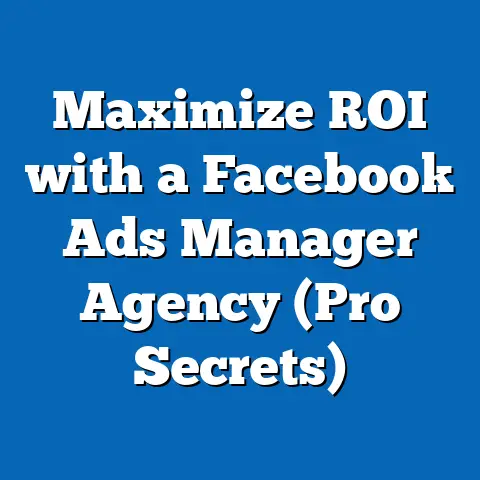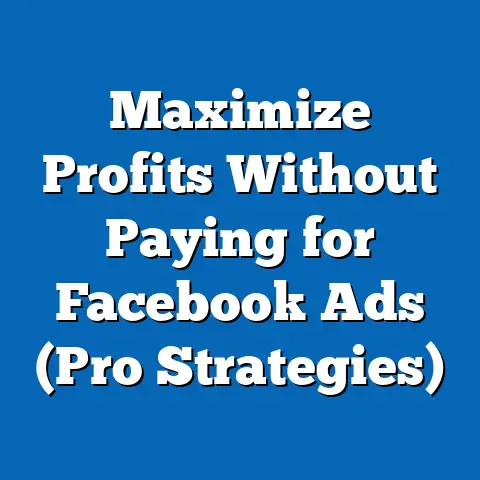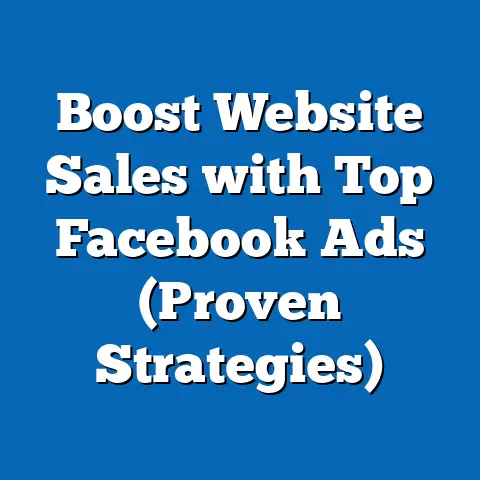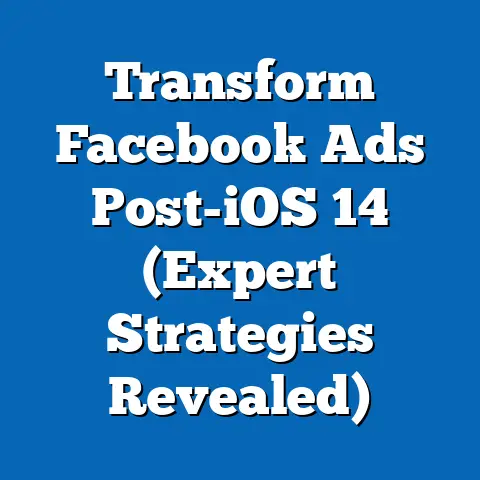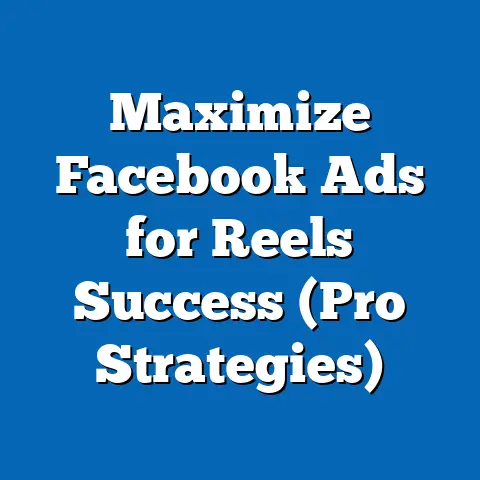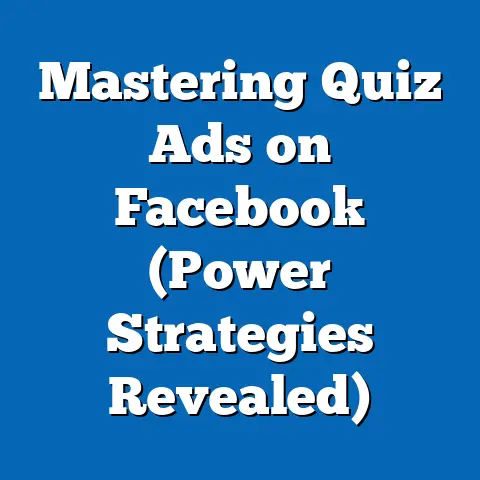Boost ROI with Effective Facebook Search Ads (Expert Insights)
In a world where people claim to be “over” Facebook, it’s a bit ironic that businesses are still pouring millions into Facebook ads – especially search ads – hoping to strike gold. It’s like that old saying, “If you can’t beat them, join them… and spend wisely.” I’ve seen so many businesses approach Facebook advertising with a “spray and pray” method, and the results are often… well, let’s just say less than stellar. But the truth is, when done right, Facebook search ads can be a powerful tool for driving ROI.
Over the years, I’ve learned that the key to successful Facebook advertising isn’t just about throwing money at the platform; it’s about strategic planning, deep understanding of your audience, and relentless optimization. In this guide, I’ll share my insights on how to boost your ROI with effective Facebook search ads, drawing from my own experiences and expert knowledge.
Understanding Facebook Search Ads
Facebook search ads are a way to reach potential customers who are actively searching for products or services on Facebook. Unlike traditional search engine ads, which appear on search engine results pages (SERPs), Facebook search ads appear within the Facebook platform, primarily in the search results page when users type in a query.
How They Work:
- Targeting: Facebook allows you to target users based on a wide range of criteria, including demographics, interests, behaviors, and connections. This granular targeting can help you reach a highly specific audience with your ads.
- Bidding: You can choose between different bidding strategies, such as cost-per-click (CPC) or cost-per-impression (CPM), depending on your campaign goals.
- Ad Placements: Facebook search ads appear in the search results page when users type in a query.
Advantages Over Traditional Search Engine Ads:
- More Engaging Ad Formats: Facebook allows for more visually appealing and engaging ad formats compared to traditional search engine ads. You can use images, videos, and carousels to capture the attention of your audience.
- Deeper Targeting: Facebook’s rich user data allows for more precise targeting than traditional search engines. You can target users based on their interests, behaviors, and even their connections.
- Lower Competition (Potentially): In some niches, the competition for Facebook search ads may be lower than for traditional search engine ads, which can lead to lower costs and higher ROI.
My Experience:
I remember working with a local bakery that was struggling to attract new customers. We decided to try Facebook search ads to target people searching for “cake shops near me” or “custom cakes.” By using visually appealing images of their cakes and targeting a specific geographic area, we were able to significantly increase their online orders and foot traffic.
Takeaway:
Facebook search ads offer a unique opportunity to reach potential customers within the Facebook ecosystem. By leveraging Facebook’s targeting capabilities and engaging ad formats, you can drive significant ROI for your business.
The ROI Landscape for Facebook Ads
ROI, or Return on Investment, is a crucial metric for measuring the effectiveness of any advertising campaign, including Facebook search ads. It represents the profit generated from your ad spend relative to the cost of running the ads.
Calculating ROI:
The basic formula for calculating ROI is:
ROI = (Revenue - Cost) / Cost * 100
In the context of Facebook ads, “Revenue” refers to the total revenue generated as a direct result of your ad campaigns, and “Cost” refers to the total amount spent on running those campaigns.
Key Performance Indicators (KPIs) to Monitor:
To accurately assess the ROI of your Facebook search ads, it’s essential to monitor the following KPIs:
- Click-Through Rate (CTR): The percentage of people who see your ad and click on it. A high CTR indicates that your ad is relevant and engaging to your target audience.
- Conversion Rate: The percentage of people who click on your ad and complete a desired action, such as making a purchase or filling out a form.
- Cost Per Acquisition (CPA): The average cost of acquiring a new customer through your Facebook ads.
- Return on Ad Spend (ROAS): The revenue generated for every dollar spent on your Facebook ads.
Case Studies and Statistics:
- A study by Statista found that the average ROAS for Facebook ads across all industries is around 4x. This means that for every dollar spent on Facebook ads, businesses generate an average of four dollars in revenue.
- I worked with an e-commerce client who was struggling to generate sales through their Facebook ads. After implementing a more targeted approach and optimizing their ad copy and visuals, we were able to increase their ROAS from 2x to 6x within a few months.
My Experience:
I’ve learned over the years that simply tracking the total number of clicks or impressions isn’t enough. You need to dig deeper and understand how those clicks translate into actual revenue. By focusing on KPIs like conversion rate and CPA, you can gain a much clearer picture of the true ROI of your Facebook ads.
Takeaway:
ROI is a critical metric for measuring the success of your Facebook search ads. By monitoring key KPIs and analyzing your data, you can optimize your campaigns for maximum profitability.
Expert Insights on Crafting Effective Facebook Search Ads
Crafting effective Facebook search ads requires a combination of creativity, data analysis, and a deep understanding of your target audience. Here are some expert insights to help you create ads that drive results:
Audience Segmentation:
- Know Your Audience: Before you start creating your ads, take the time to research and understand your target audience. What are their interests, demographics, and behaviors? What are their pain points and needs?
- Create Buyer Personas: Develop detailed buyer personas that represent your ideal customers. This will help you tailor your ad copy and visuals to resonate with your target audience.
- Use Facebook’s Targeting Options: Leverage Facebook’s granular targeting options to reach the right people with your ads. You can target users based on demographics, interests, behaviors, and connections.
Ad Copy and Visuals:
- Write Compelling Ad Copy: Your ad copy should be clear, concise, and persuasive. Highlight the benefits of your product or service and use strong calls to action.
- Use High-Quality Visuals: Your ad visuals should be visually appealing and relevant to your target audience. Use high-resolution images or videos that capture attention and communicate your message effectively.
- A/B Test Your Ads: Experiment with different ad copy and visuals to see what resonates best with your target audience. Use A/B testing to continuously improve your ad performance.
Examples of High-Performing Ads:
- Dollar Shave Club: Dollar Shave Club’s humorous and relatable ad copy, combined with simple and visually appealing visuals, helped them disrupt the shaving industry.
- Airbnb: Airbnb uses stunning photography and compelling storytelling to showcase unique travel experiences and inspire wanderlust.
- Nike: Nike’s inspirational ad campaigns feature athletes overcoming challenges and achieving their goals, resonating with their target audience’s aspirations.
My Experience:
I’ve found that the most effective Facebook ads are those that speak directly to the needs and desires of the target audience. By crafting compelling ad copy and using high-quality visuals, you can capture attention, build trust, and drive conversions.
Takeaway:
Crafting effective Facebook search ads requires a deep understanding of your target audience and a commitment to creating compelling ad copy and visuals. By following these expert insights, you can create ads that resonate with your audience and drive significant ROI.
The Importance of A/B Testing and Optimization
A/B testing, also known as split testing, is a crucial process for maximizing the ROI of your Facebook search ads. It involves creating two or more versions of an ad with slight variations and then testing them against each other to see which performs better.
Why A/B Testing Matters:
- Identify What Works: A/B testing allows you to identify which ad copy, visuals, and targeting options resonate best with your target audience.
- Improve Ad Performance: By continuously testing and optimizing your ads, you can improve their click-through rate, conversion rate, and overall ROI.
- Reduce Ad Spend: A/B testing can help you identify underperforming ads and eliminate them, allowing you to focus your budget on the most effective campaigns.
How to Conduct A/B Tests:
- Define Your Goal: Determine what you want to test and what metrics you will use to measure success. For example, you might want to test different ad headlines to see which generates the highest click-through rate.
- Create Variations: Create two or more versions of your ad with slight variations. For example, you might test different headlines, images, or calls to action.
- Run Your Test: Run your A/B test for a sufficient period of time to gather statistically significant data. Facebook’s ad platform provides tools for running A/B tests and tracking the results.
- Analyze Your Data: Analyze the data from your A/B test to determine which version of your ad performed better.
- Implement Your Findings: Implement the winning variations in your ad campaigns and continue testing to further optimize your performance.
Variables to Test:
- Headlines: Test different headlines to see which captures attention and generates the most clicks.
- Images: Test different images to see which resonates best with your target audience.
- Calls to Action: Test different calls to action to see which encourages the most conversions.
- Targeting Options: Test different targeting options to see which reaches the most relevant audience.
My Experience:
I’ve seen firsthand how A/B testing can transform a struggling ad campaign into a high-performing one. By systematically testing different elements of your ads and analyzing the results, you can continuously improve your performance and maximize your ROI.
Takeaway:
A/B testing is an essential process for maximizing the ROI of your Facebook search ads. By continuously testing and optimizing your ads, you can improve their performance and drive significant results for your business.
Trends and Future Directions in Facebook Search Ads
The world of Facebook advertising is constantly evolving, with new trends and technologies emerging all the time. Here are some trends and future directions in Facebook search ads that could impact future ROI:
AI and Machine Learning:
- Automated Ad Creation: AI-powered tools are making it easier to create high-quality ad copy and visuals automatically.
- Predictive Targeting: Machine learning algorithms are being used to predict which users are most likely to convert, allowing for more precise targeting.
- Dynamic Ad Optimization: AI is being used to automatically optimize ad campaigns in real-time, based on performance data.
Personalization:
- Personalized Ad Experiences: Advertisers are using data to create personalized ad experiences that are tailored to individual users’ interests and needs.
- Dynamic Product Ads: Dynamic product ads automatically showcase relevant products to users based on their browsing history and purchase behavior.
Emerging Trends:
- Augmented Reality (AR) Ads: AR ads allow users to interact with products in a virtual environment, providing a more immersive and engaging experience.
- Shoppable Ads: Shoppable ads allow users to purchase products directly from their Facebook feed, streamlining the buying process.
Expert Predictions:
- Industry experts predict that AI and machine learning will continue to play an increasingly important role in Facebook advertising, automating many of the tasks that are currently done manually.
- They also predict that personalization will become even more important, as users demand more relevant and engaging ad experiences.
My Experience:
I believe that the future of Facebook advertising lies in leveraging AI and machine learning to create more personalized and engaging ad experiences. By embracing these trends and technologies, advertisers can stay ahead of the curve and maximize their ROI.
Takeaway:
The world of Facebook advertising is constantly evolving, and advertisers need to stay up-to-date on the latest trends and technologies to maximize their ROI. By embracing AI, personalization, and emerging trends, you can create more effective and engaging ad campaigns that drive results.
Conclusion: Bringing It All Together
Maximizing ROI with Facebook search ads requires a strategic approach that combines careful planning, deep audience understanding, compelling ad creative, and continuous optimization. I’ve seen firsthand how businesses can transform their advertising results by focusing on these key elements.
It’s not enough to simply throw money at Facebook and hope for the best. You need to take the time to research your target audience, craft compelling ad copy and visuals, and continuously test and optimize your campaigns.
As we navigate the ever-changing landscape of digital marketing, it’s important to remember that success isn’t just about following the latest trends; it’s about understanding the fundamental principles of advertising and applying them in a strategic and creative way. As we navigate the irony of our digital habits, are we truly leveraging the powerful tools at our disposal, or just throwing darts in the dark?

